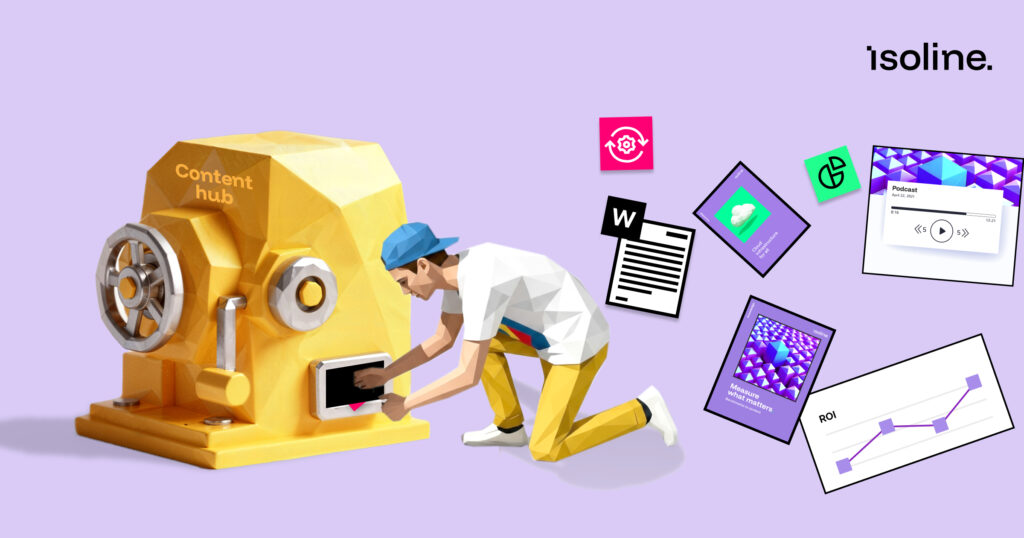You want your B2B content marketing to be ahead of the curve, right?
Well, it’s not that easy. Everything changes, and the content marketing landscape is certainly no exception. Tech, industry standards, consumer preferences – all these (and plenty of other factors) are in constant flux.
People are busy, and carving out time to keep up to date isn’t always possible.
But we’re here to help you. We spend all day every day creating cutting edge B2B content for global businesses of all kinds, so knowing this stuff is our bread and butter.
As we cruise into the second half of 2024, here are the seven B2B content marketing trends you need to keep an eye on.
1. Getting personal
With so much information at decision-makers’ fingertips these days, the process of making a final choice is often long and complicated. To really stand out from the crowd, you’ve got to go the extra mile. This means personalised content is more important than ever.
Businesses at the head of the pack have started to move beyond generic messaging and are now putting out super targeted content that speaks directly to specific personas within their target markets.
Doing this isn’t child’s play, though. It involves using data analytics and AI to create content built around individual preferences, behaviours, and needs, which will take some work. But it’s more than worth it.
The results? Highly relevant content that really rings a bell with targets, makes for enriching audience experiences, and drives long-term engagement and loyalty.
Here’s a top example of website personalisation from Spendesk, an all-in-one spend management platform designed for fast-moving businesses. It’s a simple switch that makes all the difference without feeling intrusive to the site visitor.
Original:

Personalised:

2. Video is still king
The rise of video content shows no sign of stopping. Video explains complicated things quickly and in an extremely engaging way, so its popularity among B2B audiences isn’t hard to understand.
Add to that the fact that you can maximize the reach and ROI on your videos by repurposing them on all your platforms, and video’s appeal only grows stronger.
If you want to become a recognised thought-leader in your field, then webinars, live streams, and explainer videos are the mediums for you. And be sure to make your live content available on-demand for people who couldn’t make it at the time.
Video is also a great opportunity to show some personality and establish a sense of authenticity, rather than pumping out more and more super-branded content.
All really successful B2B content marketing strategies are using video now. If you’re still not making use of it, you’d better jump on the bandwagon!
Check out this example we created for our client Verdant Technologies.
3. The robots are coming
AI and machine learning (ML) are tearing up the rule book.
By enabling more sophisticated data analysis and automation, AI and ML can be a super effective sidekick for you in pretty much all areas. Got trouble with content creation, optimisation, or distribution? This tech can give you a massive leg up over the hurdles you’re facing.
AI tools can help you come up with content ideas, refine headlines, write (very) basic articles, and even track the performance of your content in real-time. While ML algorithms can analyse data to both predict trends and support your creation of personalised content. In short, getting friendly with AI and ML will have a massive impact on the efficiency and effectiveness of what you’re doing content-wise.
BUT don’t get too friendly. This tech is by no means perfect. There are risks of inaccurate information and copyright violations, not to mention the clear lack of a human touch.
So, use AI and ML – you’ll struggle to keep pace today without them – but use them wisely.
4. Going green
With the world getting more and more conscious of the need for sustainable and ethical practices everywhere, you can’t just get on board with initiatives, you’ve got to put your shoulder to the wheel.
Content that highlights your commitment to corporate social responsibility (CSR) chimes with audiences these days – it makes clear that you’ve got more on your mind than just chasing profits and it builds a deeper connection with your brand.
But what you’re doing can’t be greenwashing. If you’re making a load of noise about your carbon offsetting but not making an effort to shrink your carbon footprint, then that’s greenwashing, and it won’t fly with audiences.
Transparent communication about your earnest efforts to help the environment, getting involved in social programs, and putting strong ethics behind how you operate day-to-day will build trust, enhance your reputation, and improve engagement.
Doing your bit to improve our world is the right thing to do – and your customers expect it of you – so you should make some noise about it in your content marketing.
Siemens’, the German multinational tech conglomerate Siemens, has had CSR on its mind – the business has been refurbishing buildings and presenting their work in videos with the hashtag #CreatingPerfectPlaces. Have a look at one of their videos. This is ethical marketing done just right.
5. Interactive content
Interactive content like quizzes, polls, assessments, and interactive infographics engages audiences in a way that static content just can’t – it gets them involved.
Content of this kind provides an immersive experience that people will remember, helps SEO because of long page sessions, and, as it’s very sharable on social media, will improve your reach and visibility.
And that’s just the beginning. Interactive content also allows you to gather info about your audience’s preferences and behaviours that can be used to help with personalized comms in the future. Also bear in mind that if you go down the route of gated content, you can get access to contact details that you can use for follow-ups and nurturing.
Clearly there are a lot of upsides to publishing pieces of interactive content, so now’s the time to start thinking about integrating them into your content marketing mix.
Paychex, which provides payroll and HR solutions, offers interactive quizzes to help prospects identify pain points. This is a great way of finding out more about your leads while making them feel like they’re getting value out of sharing their data: a win-win scenario.

6. Voice search
Alexa, Siri, Google Assistant, and alike are making their presence felt. Optimising content for voice search is now something everyone in the B2B marketing game should consider.
Because of the growing popularity of these voice-activated assistants, doing well from an SEO perspective now requires a different approach.
Voice search queries are, for the most part, much longer and more conversational than text searches, so you’ll need to think about natural language processing and focus on long-tail keywords to make sure your content is easily discoverable through voice search.
It’s also useful to know that incorporating FAQ sections and adding conversational touches to your content will help you out when it comes to voice search optimization.
7. Influencer partnerships
Influencer campaigns aren’t just the preserve of B2C marketers anymore.
As AI continues its growth, humans increasingly want to hear from other humans, and this is especially the case in tech B2B.
From leveraging popular B2B podcasts and newsletters, to sponsoring YouTube videos, there are a million ways to get your brand name next to that of industry experts, and get kudos by association.
Or you could take a leaf out of SAP’s book and invite influencers to engage at your events, or contribute to your longform content. That way you can leverage their reach, influence, and audience.
Get started
Armed with this knowledge, I hope you feel empowered in your B2B content marketing endeavours for the rest of the year. As always, we’re happy to help support you in your efforts, please reach out at hello@isolinecomms.com




